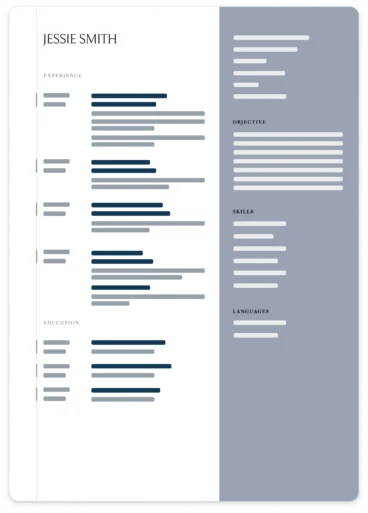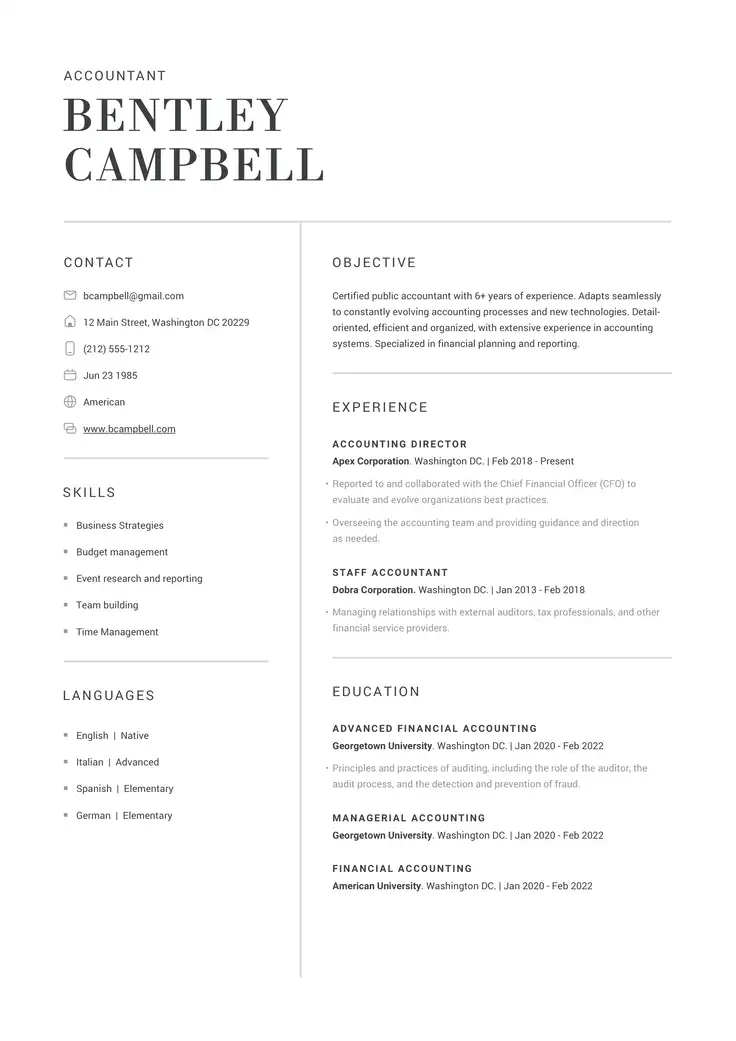Microbiologist Resume Samples
1. Candidate seeking microbiology postition
[Dr. Alex Johnson]
[Microbiologist]
[789 Microbiology Lane | Boston, Massachusetts | (456) 789-0123| alexjohnson@microbiologist.com]
Personal Statement
Detail-oriented and innovative Microbiologist with over 7 years of experience in research and laboratory environments. Specializes in using advanced equipment and aseptic procedures to isolate, analyze, and test organisms. Proven track record of contributing to scientific understanding by uncovering key environmental interactions. Committed to maintaining the highest safety standards while operating in diverse facility settings. Proficient in establishing cultures of various tissue types and microorganisms.
Experience
Senior Microbiologist | XYZ Labs, Boston, MA | July 2017 – Present
- Lead a team of 5 microbiologists, overseeing the use of advanced laboratory equipment and the enforcement of aseptic procedures.
- Successfully isolated and cultured 50+ types of tissue and microorganisms, advancing our understanding of their environmental interactions.
- Introduced stringent safety measures that reduced laboratory incidents by 30%.
Junior Microbiologist | ABC Solutions, San Francisco, CA | June 2016 – June 2017
- Assisted in analyzing and testing various organisms, contributing to 5 significant research projects.
- Maintained an aseptic laboratory environment, minimizing the risk of sample contamination.
- Played a key role in the preparation of 300+ tissue cultures and organism samples.
Education
Ph.D., Microbiology | Massachusetts Institute of Technology, MA | 2016
Master’s in Biotechnology | University of California, San Diego, CA | 2011
Bachelor’s in Biological Sciences | University of California, Berkeley, CA | 2010
Publications
- Johnson, A., et al. (2022). “Impacts of Microbial Interactions on Environmental Sustainability.” International Journal of Career Searching.
Skills
- Isolation and Analysis of Organisms
- Aseptic Procedures & Safety Protocols
- Equipment Operation & Maintenance
- Tissue and Microorganism Culture Establishment
- Scientific Contribution & Research Publication
Microbiologist Resume Vocabulary & Writing Tips
As a scientist, you understand that even the smallest of variables produce results in an experiment’s outcome. The same is true of your microbiologist resume. Resume keywords represent only a small portion of your resume, but they make a big difference in the hiring process.
Today, most resumes are analyzed by software with the purpose of identifying pre-programmed resume keywords. In order to score well, your resume should contain some of these keywords, often found in the job description. We’ve also compiled the following list of common microbiologist resume vocabulary terms for your convenience.
When your resume is complete, be sure to proofread it carefully. Look for and correct any errors in spelling, grammar, or punctuation.
Words to Use
- Tissue
- ELISA
- Specimen
- Laboratory
- Sample
- Cultures
- Environmental
- Safety
- Organism
- Bacteria
- Equipment
- Procedures
- Serological test
- Microorganism
- Facility
- Aseptic
Action Verbs
- Analyze
- Uncover
- Perform
- Monitor
- Sample
- Isolate
- Test
- Evaluate
- Find
- Maintain
- Identify
- Contribute
- Discover
- Culture
- Classify
- Direct
Microbiologist Resume Tips and Ideas
Microbiologists study microscopic organisms such as bacteria, viruses, and protozoa. They may work in the healthcare field or in a number of other fields, including manfacturing, environmentalism, food, farming, or others.
Microbiologists typically do their work in offices and laboratories, but some jobs may also require fieldwork to obtain samples. Microbiologists test samples of water, tissue, blood, food, feces, soil, surfaces, or other items for the presence of disease-causing microorganisms.
Would you like to make advancement in your microbiology career? A fresh, modern resume can help you to do just that. You can use our suite of resume writing tips and professional resume samples to help you create an ideal resume today.
Format
A chronological resume format is recommended.
Design
When designing your microbiologist resume, consider:
- A professional appearance
- Sections, headings and margins
- Infographics
Photo
No
Sections
Required:
- Contact information
- Skills
- Work history
- Education
Optional:
- Resume objective
- Certifications
- Language proficiency
- Publications
Resume Length
One page, letter size, 8.5 by 11 inches
Format
A chronological resume format is recommended for careers in the sciences, including microbiology. To create a resume in this form, you will begin by listing your contact information and skills. You will then proceed to list your work history and educational background in reverse-chronological order, that is, beginning with the most recent experience. Additional sections may also be included, as discussed below.
Because education is very important to your microbiologist resume, functional and combination resume formats are not recommended.
Design
How should a microbiologist resume look? Just as you are a professional in your field, so should your resume sport a professional appearance. This can be accomplished in a few easy steps. First, select a single, easy-to-read font and use it throughout the document. We recommended 11 or 12-point Calibri or Arial.
Then, group your text into logical sections. Give each section a heading, such as “Skills,” “Experience,” and “Education.” This will help your hiring manager quickly find the information they need. You can further highlight these headings by using bold fonts or a slightly larger font size. Finally, leave ample margins around each section of text for a crisp, clean appearance.
If you need some help getting started, you can use an online resume template or base your resume on one of our professional resume examples.
Another consideration is the infographic. Infographics can add appeal to your resume and convey information in a succinct and engaging way. Research your company’s culture to determine whether this creative style would be welcome. If so, use simple graphics to display information such as the type of sampling and labwork you’ve accomplished.
Photo
It is not necessary to include a photo with your microbiologist resume. In fact, in some countries, such as in the United States, the inclusion of an unsolicited photo could result in the rejection of your resume due to anti-discrimination laws.
Sections of a Microbiologist Resume
A number of sections are vital to the success of your microbiologist resume. These include:
- Contact information
- Skills
- Work history
- Education
The above resume sections are the absolute minimum needed to show your hiring manager that you have what it takes to do your job well. Additional, optional sections can be utilized to further prove your value as an employee. These include but are not limited to:
- Resume objective
- Certifications
- Language proficiency
- Publications
How can these optional sections be of service to you? The resume objective statement is used to grab the attention of your prospective employer, often by highlighting a major past accomplishment.
Certifications can add weight to your skills list, as can publication of articles in peer-review journals. Some relevant certifications could include OSHA training in safety inspection techniques, respiratory protection, bloodborne pathogen exposure control, or health hazard awareness. Proficiency in any language other than English should also be included on your resume.
Resume Length
Generally, your resume should be limited to one page in length. If you have many qualifications, such as a long list of publications, you may extend this to two pages. Do not exceed two pages.
Microbiologist Resume Section Headings
Choose 2-3 sections. The most important for the profession.
Your education, skills, and work experience are among the most important sections of your microbiologist resume.
Education
A bachelor’s degree in biology or microbiology is generally required for entry-level microbiologist positions. In order to secure a promotion, advanced degrees in biology, chemistry, or related fields will be required.
Skills
The microbiologist should be skilled in analyzing samples of tissue, blood, water, or other solids and fluids, depending on the field in which he or she is employed. In some positions, the microbiologist will also also be required to collect said samples.
The microbiologist should be able to isolate and maintain cultures of bacteria or other organisms, often using a petri dish. He should be able to identify the organisms found in specimens or cultures using microscopes and slides. He should also be familiar with the testing techniques used in the specific industry. For example, a microbiologist in the healthcare field will likely perform serological or enzyme-linked immunosorbent assay (ELISA) tests on patients’ blood.
Work experience
All work experience from at least the last ten years should be included on your resume. Prior experience in microbiology or healthcare is ideal. What if some of your experience is not relevant to your current microbiology career? You can use the resume job descriptions to highlight transferable skills like teamwork, attention to detail, or problem-solving.
Related Professions


